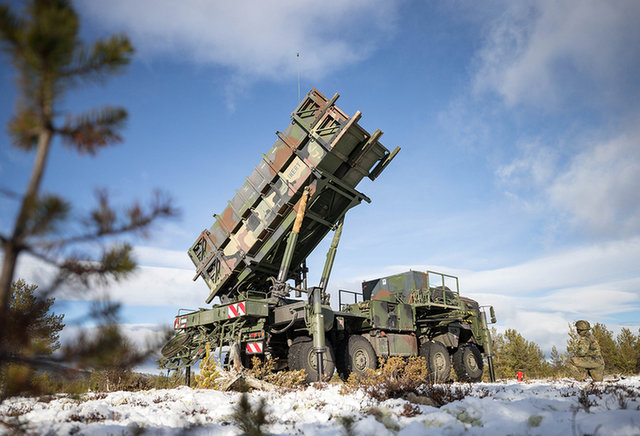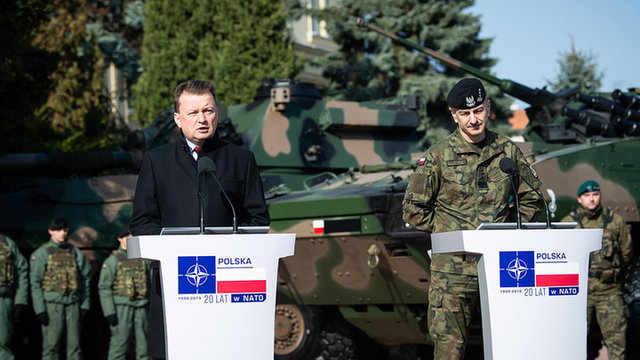Regional Focus
From Russia to NATO: the logic behind Poland’s military modernisation
Poland is one of the few countries in the 29-strong NATO alliance that spends over 2% of GDP on defence. With a belligerent Russia on its eastern flank, Poland is continuing to modernise its armed forces. Grant Turnbull finds out what the country wants, and whether it can afford it.

Poland’s modernisation plan includes new fifth-gen fighters to replace Russian Mig-29 aircraft. Image: Piotr Zajc / Shutterstock.com
Poland is in a precarious position, sandwiched between East and West and historically where great powers have fought for control over the European continent. Today, as we enter another period of great power competition, Poland once again faces the prospect of being the battleground of a potential NATO-Russian conflict.
Indeed, one of NATO’s weakest strategic points is located in northern Poland: the Suwalki Gap, a 65 mile-wide strip that links Lithuania and the Baltics to the rest of NATO.
Military analysts see this gap - which has the highly militarised Russian enclave Kaliningrad to the west and Belarus to the east - as analogous to the Cold War-era Fulda Gap in Germany, where NATO once prepared its forces for surprise Soviet tank attacks coming from Eastern Europe.
In this new geopolitical context, Poland isn’t taking any chances and is prioritising the modernisation of its defence forces to ensure it can defend itself against a potential Russian invasion, as well as contribute to wider NATO missions both in and outside of the European theatre.
In February, Poland’s Minister of National Defense, Mariusz Błaszczak, announced a new Technical Modernisation Plan (TMP) for the armed forces, covering the years 2017-2026.
This roadmap is valued at PLN185bn (€43.2bn), which Błaszczak noted was PLN45bn more than the previous TMP covering 2013-2022. Equipment in the plan includes new fighter aircraft, air defence systems, cyber defences, drones and submarines. Much of this equipment will be prioritised for Poland’s new 18th Mechanised Division, which will consist of three brigades and be based in the east to shore up the vulnerable eastern flank.
“This is a record plan when it comes to value,” said Błaszczak. “This is obviously a big challenge, but also a chance to develop the defense capabilities of the Polish Army.”
Poland’s defence budget: not all that it seems
Analysts have, however, noted that the headline PLN185bn figure is actually less, owing to the fact that the TMP covers 2017 and 2018, which have already passed.
“There are some discrepancies in this number,” says Dominik Kimla, a Warsaw-based analyst with consultancy Avascent. He noted that if you remove the expenditure from 2017/18 as well as take into account several large contracts that have been placed recently for military equipment, the actual pot of money allocated for defence modernisation up to 2026 is closer to PLN128bn. However, according to Avascent Analytics’ analysis, Poland might only be able to allocate about PLN83bn to new military hardware by 2026.
The Polish MoD has also stated that 39% of MoD funds will be dedicated to procurement by 2026.
“The forecast that was disclosed by the MoD was based on very optimistic assumptions,” explains Kimla, “both in terms of Polish GDP growth and also in terms of allocation of procurement spending in relation to the whole MoD budget.”
“There is no such thing as continuity in defence planning in Poland.”
Poland has ambitions to spend 2.4% of GDP on defence by 2026, a number set to increase to 2.5% by 2030. According to the most recent NATO figures, Poland currently spends 2.05% of GDP on defence.
Again, Kimla doubts that this can be achieved, especially as the Polish Government looks to increase spending on non-defence initiatives. “If you take into perspective [that] GDP growth over the next few years will be slower than the last one or two years, we believe that Poland will spend only 2.2% of GDP by 2026,” he explains.”
Other analysts have also questioned the modernisation plan says Konrad Muzyka, an Gdansk-based defence analyst. “Each consecutive government tends to prepare its own modernisation programmes, which usually stands in opposition to what was pursued previously. This of course leads to chaotic procurement.”

The Polish Army wants to upgrade its main battle tank fleet, including its PT-91s, an evolution of the Russian T-72. Image: US DoD
Fifth-gen fighters are a priority
The TMP singles out acquiring new fifth-generation fighter aircraft for the Polish Air Force as the “most important programme”. Under what is known as the Harpia programme, Poland wants to purchase at least 32 fifth-generation fighters to replace its increasingly unreliable Soviet Su-22 and Mig-29 aircraft.
“The MiG-29 fleet is in a dire condition,” says Muzyka, noting that three aircraft had crashed in less than 18 months. He adds that the decision to accelerate Harpia has likely been influenced by the spate of crashes and looming elections.
Other aviation priorities in the TMP include the long-running Kruk programme, which aims to acquire a new attack helicopter to replace the Russian-designed Mi-24 “Hind”. The MoD also wants to acquire a new medium-range tactical unmanned aerial vehicle (UAV) as part of its Gryf programme as well as a micro UAV to be used in urban areas under the Ważka programme. A new strategic reconnaissance aircraft is also planned as part of the Płomykówka programme.

As part of the Kruk programme, the Polish armed forces are looking to replace the ageing Mi-24 Hind attack helicopters. Image: US DoD
Protecting the skies
Another key item on the agenda is modernising equipment that will defend Polish skies from enemy aircraft or incoming missiles. Last year, the MoD signed a multi-billion dollar contract with US manufacturer Raytheon for the Patriot air and missile defence system as part of the Wisla programme. This is one of the largest defence contracts in Polish history.
A Phase II is also expected, although Muzyka told us that if it went ahead, the government’s defence budget would “be depleted in the near term to the point that no major acquisitions will be conducted”.
Industry is also preparing for another air defence programme known as Narew, a short-range air defence requirement that will provide yet another layer of protection from enemy air attacks.
The country’s land forces are also acquiring new tracked self-propelled artillery pieces, known as the Krab, and self-propelled Rak mortar vehicles, to support indirect fire missions and replace dated Soviet machines. Long-range firepower will also be improved with the acquisition of the US-made High Mobility Artillery Rocket System (HIMARS) from Lockheed Martin.

Last year, the Polish MoD signed a contract with Raytheon for the Patriot air and missile defence system as part of the Wisla programme. Image: US DoD
Preparing for mechanised war
New anti-tank missiles are also expected to be procured under the Pustelnik programme, as well as new Borsuk infantry fighting vehicles to replace the army’s Soviet BWP-1 examples.
With the threat from mechanised warfare at its greatest since the end of the Cold War, Poland is also investing in upgrading its tank fleet including former German Army Leopard 2s and its fleet of PT-91s. Older tanks that have been in storage could also be regenerated for reserve units.
The country’s modernisation agenda also calls for a fleet of new Orca submarines for the navy as well as new coastal defence ships.
“It is still unclear when the main programmes in the modernisation agenda will be contracted to industry.”
Another key element is bolstering the armed forces’ cyber capabilities, particularly as NATO now defines this as a military domain and Russia continues to use this method of attack against adversaries, including interference in domestic political affairs. Under what is known as CYBER.MIL.PL, Poland will invest PLN3bn (€700m) in cyber capabilities as part of the modernisation agenda.
Several of the acquisitions mentioned above have been delayed, with sources noting that contracts for a number of programmes were expected around 2017 or 2018, although nothing has yet materialised.
It is still unclear when the main programmes in the modernisation agenda will be contracted to industry, with Poland having a history of drawn out programmes that could be delayed further or cancelled. Nevertheless, defence remains a top priority and increased defence spending means that Poland will be one of the key NATO players going forward.

In February, Poland’s defence minister announced a new Technical Modernisation Plan valued at €43.2 billion. Image: Polish MoD